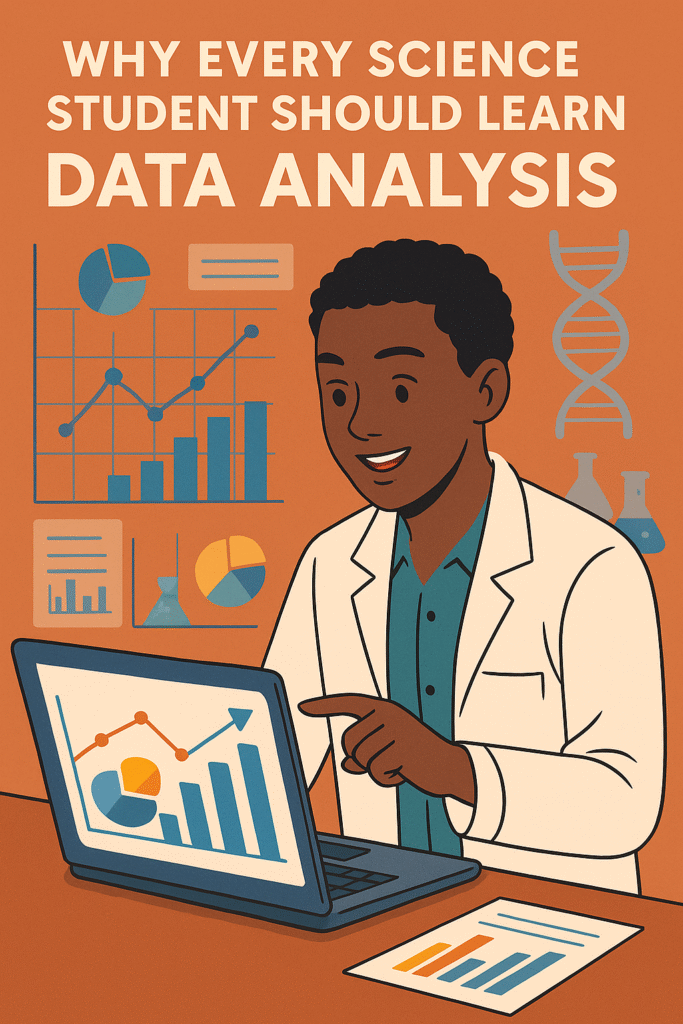Why Every Science Student Should Learn Data Analysis
In today’s world, scientific discovery isn’t just about the lab—it’s about what you do with the data. Whether studying physics, biology, chemistry, environmental science, or health, data analysis is the amplifier that turns raw observations into patterns, predictions, and breakthroughs. If you’re a science student, here’s why mastering data analysis isn’t optional—it’s essential.

1. Science Today Is Data-Driven
Almost every scientific paper you see in journals includes graphs, regression models, classification algorithms, or cluster analyses. From genomics to climate models, physics experiments to behavioral studies—data is the language that describes what’s happening. Without analysis skills, you’re a consumer, not a participant, in modern science.
2. Better Interpretation & Critical Thinking
Data analysis forces you to question assumptions. Why is one data point an outlier? What is the distribution? Are there hidden biases or missing values? These questions sharpen your scientific mindset. Understanding confidence intervals, p-values, error bars, and model limitations prevents you from drawing misleading conclusions.3. Making Sense of Big & Noisy Datasets
Many scientific fields generate massive, messy data—’electrophoresis gels, satellite imagery, sensor logs, gene expression arrays, etc. A biologist might have hundreds of RNA datasets; an environmental scientist might get terabytes of climate readings. Knowing how to wrangle, visualize, and analyze such data sets you apart from students stuck doing “by hand” preprocessing.
4. Skills That Boost Employability
Data analysis skills are in high demand across industries—pharma, healthcare, finance, energy, environmental consulting, research labs. A science graduate who can code in Python, build dashboards, run regressions, or build predictive models is far more competitive in the job market.
5. Enables Personalized Research
Rather than relying solely on existing papers, you can design your own experiments, collect data, and analyze it—tailoring new hypotheses, comparing conditions, or validating models. That autonomy accelerates your scientific growth and creativity.
6. Facilitates Interdisciplinary Collaboration
Scientists increasingly collaborate with engineers, economists, policy makers, and tech teams. Data literacy lets you speak the same language—coordinate models, merge datasets, communicate visually via dashboards, or embed lab results into decision systems.
7. Real-World Examples
- Ecologists using sensor and satellite data with machine learning to map deforestation.
- Medical researchers analyzing patient records and lab tests to detect early disease markers.
- Chemistry students building predictive models for molecular structure–activity relationships.
- Physics labs using data to detect anomalies or instrumentation drift through time-series analysis.
Getting Started: Resources & Tools
- Languages & libraries: Python (Pandas, NumPy, SciPy, scikit-learn), R (tidyverse, ggplot2).
- Visualization tools: Matplotlib, Seaborn, Plotly, Tableau, Power BI.
- Courses & tutorials: Free MOOCs (Coursera, edX), YouTube series, university departments.
- Projects: Start with a small dataset—weather data, stock prices, student scores—and explore relationships, build models, present results.
Final Thoughts
If you’re a science student in 2025, data analysis is no longer optional—it’s foundational. It empowers you to turn observations into insight, experiments into evidence, and questions into breakthroughs. Master it, and you’re not just studying science—you’re creating it.
To Run Analysis, visit https://analysis.africa NOW!